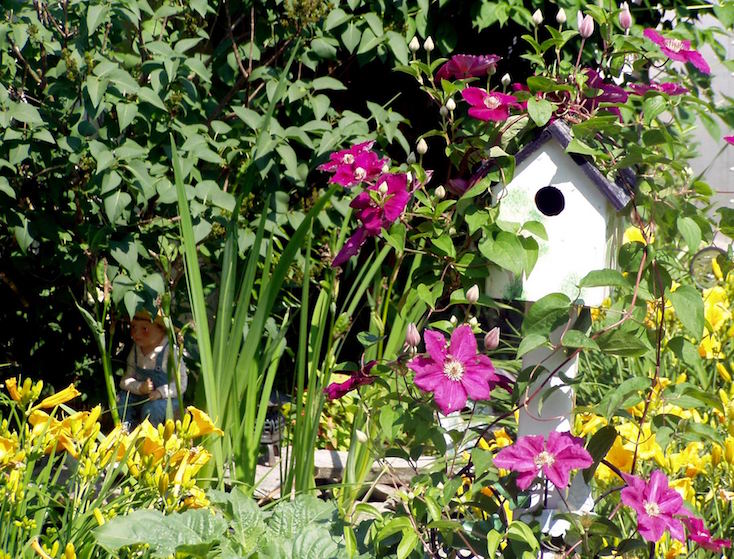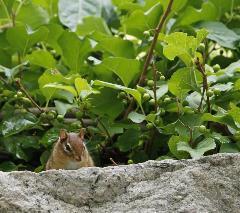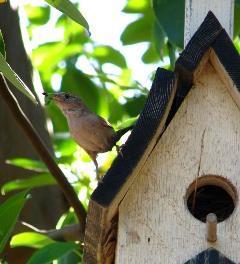All creatures need shelter
No matter your gardening style, resources or how much green space you have to play with, wildlife-friendly gardening is possible for everyone. And it can be so beautiful!
The colourful blooms, berries, fall foliage and diverse plantings that create interesting texture in the garden year-round can also nurture birds, butterflies and other beneficial creatures.
In this blog, we are going to discuss the importance of wildlife-friendly shelter areas in your yard and garden. Not only does shelter protect wildlife from extreme temperatures, rain and other harsh weather, it also helps them hide from predators and provides them with places to safely raise their young.

OLYMPUS DIGITAL CAMERA
Tip 1: Look to neighbouring natural areas
If you include features of the neighbouring habitat on your property, wildlife will see your garden as an extension of their existing habitat and you will be able to attract species that would otherwise see your property as too small or too foreign.
Tip 2: More variety is better
As with food, a variety of plant types attracts a greater diversity of wildlife. Planting evergreens, for instance, provides effective cover in the cold winter months while deciduous trees (those that shed their leaves) help block excessive sun but allow for more air circulation.
Differing heights are also important for shelter. Birds such as hawks tend to prefer the top portion of tall trees, while the whip-poor-will and ovenbird nest on the ground. The northern flying squirrel and bats and also seek shelter in plants of various heights, as do do tree frogs.
The different stages of a plant’s life can also attract differing species of wildlife. If you want to be really adventurous in planning your garden, incorporate dead wood, which can be surprisingly visually pleasing as well as being perfect for roosting as well as for nesting animals who prefer these environments.
Tip 3: Nice place to raise a family
 Smaller animals, like our pollinators, need places to lay their eggs. This can include a flower garden or wild area in a corner for butterflies or a patch of bare ground for certain bees. Also try to group plants, allowing for denser cover in places. Structures such as rock piles are also very useful to wildlife, as are wet areas like ponds that can offer refuge at night.
Smaller animals, like our pollinators, need places to lay their eggs. This can include a flower garden or wild area in a corner for butterflies or a patch of bare ground for certain bees. Also try to group plants, allowing for denser cover in places. Structures such as rock piles are also very useful to wildlife, as are wet areas like ponds that can offer refuge at night.
Tip 4: Minimize lawn space
Many of us have good uses for lawns — kicking the ball with our children, sitting outdoors with friends or simply providing a smooth green contrast to our textured and colourful garden beds. However, see how much lawn you can replace with lush vibrant habitat. Shifting the balance to include more natural habitat will go a long way in supporting wild species. As an added bonus, a smaller lawn means less lawn maintenance which can save time, money and reduce pollution.
Tip 5: Supplemental shelters
 Nesting and roosting boxes, if placed in a good location, help to make up for any shortage of places for birds to nest and rest. The location of your shelter can be just as important as the shelter itself. Bat boxes need to be in sunny spots like on south facing house walls or poles. Trees and shrubs are important to have near a feeder but ensure they aren’t so close to allow a cat to jump out and catch a bird.
Nesting and roosting boxes, if placed in a good location, help to make up for any shortage of places for birds to nest and rest. The location of your shelter can be just as important as the shelter itself. Bat boxes need to be in sunny spots like on south facing house walls or poles. Trees and shrubs are important to have near a feeder but ensure they aren’t so close to allow a cat to jump out and catch a bird.
Happy gardening!
Getting certified
In certifying properties, the CWF looks to see if your outdoor space meets the needs of wildlife. The program encourages a well-rounded approach that includes natural features which support a diversity of wildlife.
The CWF website will guide you through these different components, and you can sign up to receive updates, including additional blogs in this series on CWF Backyard Certification where we will dive into the details of how to make your backyard a welcoming paradise for Manitoba wildlife!
